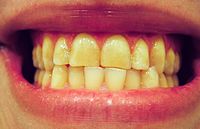
Photo from wikipedia
Oral appliance therapy is a recommended alternative to CPAP for OSA. Approximately 50% of patients have a major reduction in OSA severity but successful treatment outcome remains challenging to predict.… Click to show full abstract
Oral appliance therapy is a recommended alternative to CPAP for OSA. Approximately 50% of patients have a major reduction in OSA severity but successful treatment outcome remains challenging to predict. Previous prediction methods have focused on clinical variables which have poor predictive value. OSA is recognised as a heterogenous disorder caused by 4 pathophysiological traits. The influence of OSA pathophysiological traits on oral appliance treatment outcome has been explored in recent physiological studies using simplified phenotyping methods. In this preliminary report, we prospectively compared differences in the 4 OSA phenotypes between responders and incomplete responders to a novel oral appliance with built in oral airway using gold standard phenotyping methodology. Data from 22 people with OSA (AHI>10events/h) have been analysed to date. A diagnostic in-laboratory PSG was initially conducted to confirm OSA. A detailed physiology PSG was carried out prior to commencement of oral appliance therapy. For this study night participants were instrumented with standard PSG equipment, nasal mask, pneumotachograph, epiglottic pressure catheter and intramuscular electrodes inserted perorally into the genioglossus to quantify baseline OSA phenotypic traits. Pcrit was quantified via CPAP dial downs and the non-anatomical traits were quantified from naturally occurring apneas and hypopneas. Participants were then fitted with a next generation novel oral appliance with a built-in oral airway (Oventus O2Vent Optima™) and titrated to at least 75% of maximum mandibular advancement. After acclimatization to therapy, participants were invited to undergo a treatment efficacy PSG. Oral appliance therapy reduced the AHI by 52% (21[15,31] vs. 11[7,16] events/h, p<0.001). 46% of participants responded to oral appliance therapy based on the definition of AHI < 10events/h. Preliminary analyses indicated that estimates of baseline upper airway collapsibility tended to be different in responders versus non-responders (responders have less collapsible airways). The novel oral appliance reduced OSA severity by 50% with resolution of OSA in half of participants. Baseline pharyngeal collapsibility may be an important physiological predictor of treatment outcome. Support (if any):
Journal Title: Sleep
Year Published: 2021
Link to full text (if available)
Share on Social Media: Sign Up to like & get
recommendations!